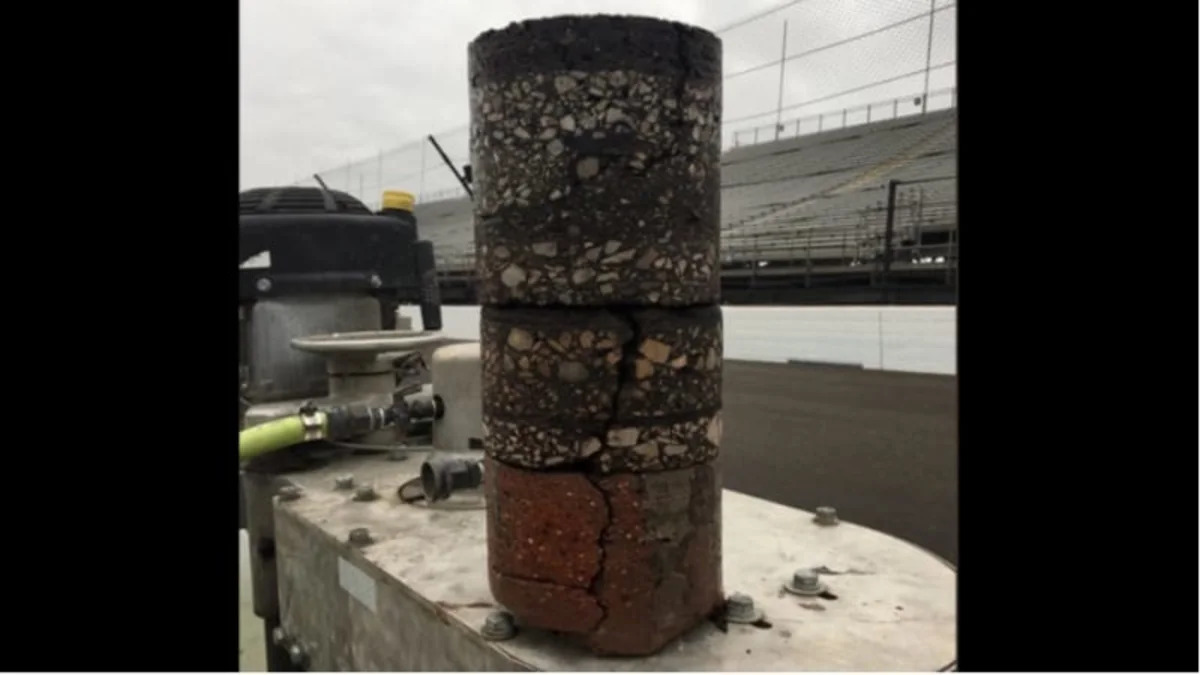Road surfaces inevitably break down and need to be repaved. That's true of any road, be it a city street, interstate or even a race track. Cars and trucks barreling around the same piece of pavement for miles and miles and miles take their toll. In the 108-year history, the track surface has changed and been redone so many times that this core sample tweeted out by the speedway stands more than 18 inches tall. Have a look at all the changes through the years.
While Indy may be known as the Brickyard, the very first iteration of the track surface in the spring and summer of 1909 consisted of a 2-inch-thick layer of creek gravel, a 2-inch layer of crushed limestone and a layer of taroid. That was followed by a half-inch layer of stone chips mixed with larger stones. That was topped with another layer of taroid (a coal-tar preparation) with stone dust worked into the surface.
In the fall 1909, a two-inch layer of sand was put down, then 3.2 million road-paving bricks were placed. There was roughly a quarter of an inch between each brick. After the surface was leveled, a concrete was poured between the bricks to hold things in place.
That brick surface lasted more than 50 years. In 1961, nearly the entire track surface was covered with asphalt, leaving just a three-foot strip of bricks at the start/finish line. That strip remains there to this day. In 1976, the entire track was cleared and resurfaced for the first time since 1909. Further track work took place in 1988, 1995, 2002 and 2004 — the core sample reflects eight layers in all, but of course doesn't reflect material that was removed. The last round of work included the pit and warm-up lanes, too.
Related Video:
Did you see the core sample @jdouglas4 shared last week?
— Ind. Motor Speedway (@IMS) October 31, 2017
Check out the graphic below to see what's behind the surface ⬇️ pic.twitter.com/l6K8WFBZD5
While Indy may be known as the Brickyard, the very first iteration of the track surface in the spring and summer of 1909 consisted of a 2-inch-thick layer of creek gravel, a 2-inch layer of crushed limestone and a layer of taroid. That was followed by a half-inch layer of stone chips mixed with larger stones. That was topped with another layer of taroid (a coal-tar preparation) with stone dust worked into the surface.
In the fall 1909, a two-inch layer of sand was put down, then 3.2 million road-paving bricks were placed. There was roughly a quarter of an inch between each brick. After the surface was leveled, a concrete was poured between the bricks to hold things in place.
That brick surface lasted more than 50 years. In 1961, nearly the entire track surface was covered with asphalt, leaving just a three-foot strip of bricks at the start/finish line. That strip remains there to this day. In 1976, the entire track was cleared and resurfaced for the first time since 1909. Further track work took place in 1988, 1995, 2002 and 2004 — the core sample reflects eight layers in all, but of course doesn't reflect material that was removed. The last round of work included the pit and warm-up lanes, too.
.@IMS history is mesmerizing. Track work 2Day included core samples & brick at bottom of this core was laid 108 years ago almost to the day! pic.twitter.com/euek21wawl
— J. Douglas Boles (@jdouglas4) October 27, 2017
Related Video:


Sign in to post
Please sign in to leave a comment.
Continue